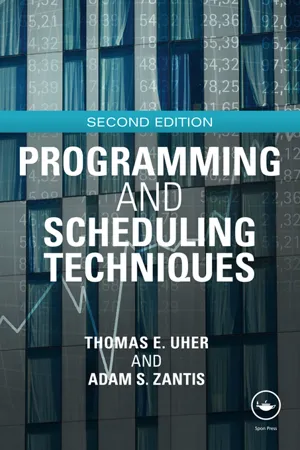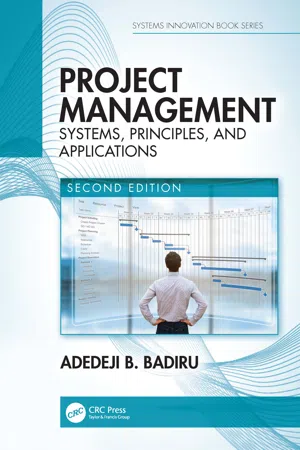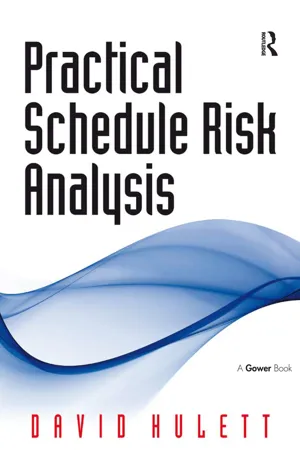Mathematics
Critical Path Analysis
Critical Path Analysis is a project management technique used to identify the most crucial tasks in a project and determine the shortest time needed to complete it. It involves creating a network diagram to visualize the sequence of activities and their dependencies. By identifying the critical path, project managers can focus on optimizing these key tasks to ensure the project stays on schedule.
Written by Perlego with AI-assistance
8 Key excerpts on "Critical Path Analysis"
Learn about this page
Index pages curate the most relevant extracts from our library of academic textbooks. They’ve been created using an in-house natural language model (NLM), each adding context and meaning to key research topics.
- eBook - ePub
- Saleh A. Mubarak(Author)
- 2019(Publication Date)
- Wiley(Publisher)
This discussion was followed by another Recommended Practice No. 92R‐17, Analyzing Near‐Critical Paths, which discusses the significance of near‐critical paths, both from deterministic and stochastic perspectives. It also makes important recommendations.Both papers underscore the point that project scheduling is not an exact science, so all the calculations are predictions of future occurrences, but it is important to follow educated common sense as well as professional recommendations in making these predictions as accurate as possible. The papers are valuable and worth reading; however, there was no update on the definition of the critical path.PROPOSED DEFINITION OF THE CRITICAL PATH
The Critical Path is the path on a logic network that takes longest calendar time than any other path in the network, from its start to its finish. This path takes in consideration the expected durations of activities along that path, the type of logical relationships and lags among these activities, work calendars11 for activities and lags, imposed constraints, resources limitations, risk, and other time‐impacting factors. It represents the minimum span of time to get the project completed.The length of the path depends on the CPM calculations using activities durations, logic, and other schedule and resource constraints. However, the criticality of the path, measured by the amount of float, depends on the imposed finish date.Risk must be taken in consideration in both activities' durations and time contingency (“weather days” in work calendars). Most likely, we will still follow a deterministic, not stochastic, approach but take the risk factor in consideration when estimating activities' durations as well as project time contingency (management float).As a shorter version of the definition, we can say: The Critical Path is the continuous timespan of activities, events, and hold time that drive the project to the finish point.Tip Box 13.1
Project managers: Read the CPM reports carefully, but also follow your own observations and instinct to decide what is critical and what may likely become critical. Do not allow the software to make the decision solely! - eBook - ePub
Engineering Money
Financial Fundamentals for Engineers
- Richard Hill, George Solt(Authors)
- 2011(Publication Date)
- Wiley(Publisher)
Appendix 2 Critical Path AnalysisWHAT’S A CRITICAL PATH?Any and every project is made up of a number of activities, some of which depend on others being completed before they can start. We saw how, when building a house, the foundations have to be finished before the walls can be started and the roof can’t be put on until the walls are up, but digging the rain water soakaway can be done at any time.The critical path is that sequence of interdependent activities that together determine the duration of the project. Activities on the critical path do not have any time between completing one activity and starting the next. Identifying that critical path determines the length of the project, and each activity on it must be completed in the allocated period of time otherwise the whole project will overrun. Activities not on the critical path can overrun within a period of time, called the “float,” which does not affect any critical activity.Critical Path Analysis (CPA) is one of a number of tools—all now available as software packages—that have been developed to allow the project manager to calculate the time required for completion of the project and to see which are the critical activities.ACTIVITY LISTThe first step in CPA is to prepare a list of all the activities that make up the project and, for each, identify the duration and dependent activities, that is, activities that have to be completed before another can start. Let’s use the house building example as shown in Table A2.1 .Table A2.1NETWORK DIAGRAMWe can now draw a network of arrows and nodes (Figure A2.1 )—the so-called activity on arrow diagram—in which the arrows represent the activities (each identified with the duration marked on it) and the nodes (sometimes called events ) are the start or completion of an activity. This shows how the activities depend on one another The dotted line connecting node 3 to node 2 is a dummy activity - eBook - ePub
- David L. Olson(Author)
- 2020(Publication Date)
- Business Expert Press(Publisher)
CHAPTER 2 The Critical Path MethodKey points:- Presentation and demonstration of the critical path method
- Description of various types of slack
- Description of resource leveling and smoothing
- Presentation of conflicts arising from multiple project scheduling
- Discussion of criticisms of the critical path method
The critical path method provides a way to easily identify the soonest a project can be completed, given that the estimated durations of activities are accurate. Even though estimated durations are usually at variance with actual outcomes, the critical path method provides a useful analysis of which activities are time bottlenecks. The input to the critical path method is a list of each activity, its expected duration, and those activities that immediately precede this activity. “Immediately precede” in this case means that predecessor activities must be completed before the subject activity can begin and that there are no other activities between the predecessor and the activity in question.The critical path method provides a basis for identifying the criticality of specific activities, which can help determine which among competing activities can be delayed to stay within resource levels. A critical activity is an activity that must be completed on schedule or else project completion will be delayed. Therefore, critical activities are said to have no slack , or spare time to complete. A critical path is the chain of critical activities from the beginning of the project to its completion. If a project has no overall slack between the time it is to be completed and the minimum time to complete based on duration estimates, there will be at least one critical path for the project. However, there may be multiple critical paths, or more than one sequence of activities related by predecessor/follower relationships that have zero slack. To demonstrate, consider the following very simple project, consisting of five activities, as shown in Table 2.1 - eBook - ePub
- Thomas Uher, Adam Zantis(Authors)
- 2012(Publication Date)
- Routledge(Publisher)
Chapter 3The Critical Path Method3.1 IntroductionThe purpose of this chapter is to describe the concept of critical path scheduling, which is the most frequently used time-scheduling technique in the construction industry. The critical path method (CPM) will be defined first, followed by a brief history of its development. The original format of the CPM, known as the ‘arrow method’, will only briefly be discussed. It is a later version, the ‘precedence method’, that will be described in detail, including calculation of forward and backward paths, identifying the critical path, and the computation of ‘float’. An alternative computational method known as the ‘link lag method’ will also be presented.Although a bar chart is effective in communicating planning information, it lacks a computational base for more detailed analysis of a schedule. The lack of a computational algorism prevents the planner from locating a critical path (that is, the longest path through a schedule), calculating float, analysing the use of resources, and accelerating a schedule at the least possible cost.The CPM overcomes these shortcomings by providing a computational algorism for a highly detailed level of schedule analysis. Complex calculations are now universally performed by computers; however, an experienced scheduler is needed for the data input including the formulation of a logic of the production process and for the analysis of the output. Given that the output is constrained by the parameters within which the computer software operates, the planner is not only required to understand such parameters but is also expected to have sound knowledge of the theory of the CPM to be able to interpret a computer generated output and formulate an appropriate solution. For this reason, the theory of the CPM will be presented first in Chapters 3 –6 . Scheduling by computer will then be discussed in Chapter 7 - eBook - ePub
Project Management
Systems, Principles, and Applications, Second Edition
- Adedeji B. Badiru(Author)
- 2019(Publication Date)
- CRC Press(Publisher)
TS s. The steps for determining the critical path from the forward pass only are as follows:- Complete the forward pass in the usual manner.
- Identify the last node in the network as a critical activity.
- If activity i is an immediate predecessor of activity j , which is determined as a critical activity, then check ECi and ESj . If ECi = ESj , then label activity i as a critical activity. When all immediate predecessors of activity j are considered, mark activity j .
- Continue the backtracking from each unmarked critical activity until the project starting node is reached. Note that if there is a single starting node or a single ending node in the network, then that node will always be on the critical path.
Subcritical Paths
In a large project network, there may be paths that are near critical. Such paths require almost as much attention as the critical path since they have a high potential of becoming critical when changes occur in the network. Analysis of subcritical paths may help in the classification of tasks into A, B, and C categories on the basis of Pareto analysis. Pareto analysis separates the “vital” few activities from the “trivial” many activities. This permits a more efficient allocation of resources. The principle of Pareto analysis originated from the work of Italian economist Vilfredo Pareto (1848–1923). In his studies, Pareto discovered that most of the wealth in his country was held by a few individuals.For project control purposes, the Pareto principle states that 80% of the bottlenecks are caused by only 20% of the tasks. This principle is applicable to many management processes. For example, in cost analysis, one can infer that 80% of the total cost is associated with only 20% of cost items. Similarly, 20% of an automobile’s parts cause 80% of maintenance problems. In personnel management, about 20% of employees account for about 80% of absenteeism. For Critical Path Analysis, 20% of the network activities will take up 80% of our control efforts. The ABC classification based on Pareto analysis divides items into three priority categories: A (most important), B (moderately important), and C (least important). Appropriate percentages (e.g., 20%, 25%, 55%) are assigned to the categories. - eBook - ePub
- Dennis Lock(Author)
- 2016(Publication Date)
- Routledge(Publisher)
Critical path network methods were developed independently in Britain, Belgium and the US around 1950. Because the developers worked independently, several different methods emerged and some of those early methods have fallen by the wayside. Today, one method, known as the precedence system, has become universally popular. By no means the least reason for this popularity is that today’s computer programs can only work with the precedence system, and programs that could once process other network analysis methods are no longer supplied or supported. This chapter, therefore, will describe the precedence system.Critical path network analysis: a sea change in project planning methods.Critical path network analysis using the precedence system
Remember that bar charts are limited in the way they can display interdependencies between different jobs in a project. Linked bar charts are fine when there are only a few jobs to schedule but larger projects have hundreds – even thousands – of different tasks. So the first thing we need is a system that will let us show these interdependencies clearly on paper or on a computer screen. The precedence system does that very well.Logical sequence of tasks
Figure 3.1 shows how the preferred and logical sequence of project jobs can be shown in a precedence diagram. Each box in the diagram represents a project job, which is always called an activity or a task (it doesn’t matter which) in the jargon of critical path networks. The action in any network diagram always flows from left to right, so the arrowheads are not really necessary and are often not used. So the chart in Figure 3.1 - Triant G. Flouris, Dennis Lock(Authors)
- 2016(Publication Date)
- Routledge(Publisher)
14Critical Path Network Analysis in More Practical DetailThe previous chapter explained the concept and basic theory of Critical Path Analysis. Both the arrow and precedence network methods were introduced and illustrated using a case example. This chapter begins by examining some of the more practical, ‘hands on’ aspects of constructing a plan for a new project. We shall then explain some variants or slightly more advanced applications of critical path network analysis, again illustrated with case examples.MAKING A DETAILED PLAN FOR A NEW PROJECT
It should be apparent that an overall project network diagram and schedule can engender a number of sub-plans. This is particularly true for many aviation projects, where major sub-contractors or partners will carry out substantial parts of the project in separate premises, using plant, equipment and staff that are not directly employed or controlled by the main contractor. Every one of these partners and sub-contractors will need to make their own detailed plans to fit within an overall planning framework determined by the main contractor. So we need to be clear that the first project planning meeting, which is the subject of this chapter section, often sets out to produce a master network diagram and project schedule into which all the partners and sub-contractors must subsequently fit their own detailed plans.The First Planning Meeting: Who Should be There?
Every project working plan should enshrine a consensus of the ideas and commitments of those who will have to manage work on the project. This implies that the initial critical path network should be sketched at a meeting where the planner can obtain the best possible advice on what tasks need to be included, how they should be sequenced, what resources they will need and how long the responsible manager or engineer expects that each task will take.- eBook - ePub
- David Hulett(Author)
- 2016(Publication Date)
- Routledge(Publisher)
Schedule delays cause problems for the project owners and contractors. Delay claims for equitable adjustments can amount to millions of dollars. Commercial windows of opportunity are missed, or made only with products that are below-standard and with incomplete functionality. Delays in completing continuous process industry projects, such as oil well or platform projects or integrated circuit fabrication lines, can cause millions of dollars of foregone income per day. Satellite lift-offs are often planned well in advance and if the payload is not ready it may miss the launch or launch as an ‘experiment’ instead of the fully functioning item. Almost all experienced project personnel have slipped a schedule at some time in their careers and some have had most of their projects slip. This is common knowledge.In addition to slippage of the overall schedule or major milestones, the critical path often changes during project execution. In the baseline schedule a critical path is identified using typical Critical Path Method (CPM)2 scheduling. At the end of the project, however, the path that ultimately delays the project may not be the critical path identified in the baseline, but another one. The critical path changes are often the result of some risks that have occurred to cause a previously slack path (path with positive total float) to become critical. The common experience of project personnel is that CPM scheduling does not always reliably identify the path that ultimately determines the project’s completion date.Project schedules slip and critical paths change. These are two reasons project managers establish the common practice of statusing the schedule—inputting changes that have occurred since the last time—on a frequent basis, often weekly, throughout the project.Slippage and changes in the critical path also lead to the practice of project risk analysis. Risk analysis can address these two weaknesses in CPM scheduling.







